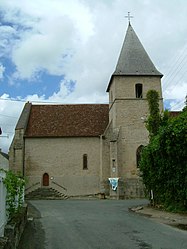Crozant
| Crozant | |
|---|---|

The church in Crozant
|
|
| Coordinates: 46°23′33″N 1°37′20″E / 46.3925°N 1.6222°ECoordinates: 46°23′33″N 1°37′20″E / 46.3925°N 1.6222°E | |
| Country | France |
| Region | Nouvelle-Aquitaine |
| Department | Creuse |
| Arrondissement | Guéret |
| Canton | Dun-le-Palestel |
| Intercommunality | Pays Dunois |
| Government | |
| • Mayor (2008–2014) | Jean Parlebas |
| Area1 | 31.9 km2 (12.3 sq mi) |
| Population (2008)2 | 511 |
| • Density | 16/km2 (41/sq mi) |
| Time zone | CET (UTC+1) |
| • Summer (DST) | CEST (UTC+2) |
| INSEE/Postal code | 23070 /23160 |
|
1 French Land Register data, which excludes lakes, ponds, glaciers > 1 km² (0.386 sq mi or 247 acres) and river estuaries. 2Population without double counting: residents of multiple communes (e.g., students and military personnel) only counted once. |
|
1 French Land Register data, which excludes lakes, ponds, glaciers > 1 km² (0.386 sq mi or 247 acres) and river estuaries.
Crozant is a commune in the Creuse department in the Nouvelle-Aquitaine region in France.
A tourism and farming village situated some 20 miles (32 km) northeast of Guéret, on the D72 and by the banks of the river Creuse, the boundary with the department of Indre.
This administrative boundary is very old. It approximates to the linguistic boundary between the langue d'oïl and langue d'oc.
It also has a geological significance: to the south, the granite foothills of the Massif central, while in the plains to the north begins the limestone of the Paris basin.
When the Eguzon dam on the Creuse was built in 1926, the landscape, society and the local economy changed under the water’s influence in just a few years. One has only to see old postcards and the works of Armand Guillaumin, who painted about 140 landscapes, to notice the difference. The moors were maintained by the extensive grazing of sheep and goats, which slowly declined between the two wars and died out completely after 1950. The trend nowadays is the restoration of surrounding ruins, and the forestation of those former natural open spaces.
The name of Crozant is probably derived from Celtic then the Latin "Croso" (which also gives us "Creuse"). The Welsh word "Croeso" means welcome and as the Welsh are Celts I suspect that there is a link. Successively known as Crozenc in 1208, Crozent in 1277, Crousant (1512) and the modern form "Crozant".
The rocky outcrop between the Creuse and its tributary, the Sédelle has been occupied since prehistoric times. A fortress appears to have been built between 997 and 1018. But it was in the 13th century that the castle we know today was built. One of the remaining towers bears the name of Isabella of Angoulême, widow of King John I of England, subsequently the wife of Hugues X de Lusignan.
In his book on the history of the region (La Marche), Joullietton reported that the castle at Crozant was taken by Catholics in 1588, which ruined one of the towers. From 1606, the castle served as a source of building material for the local people. Notes prepared in 1640, by the king’s inspector at Moulins, Voyer d'Argenson, noted that the castle was in a sad state. The remains of the stronghold, which had belonged to the Crown since the confiscation of all the property of Charles III, Duke of Bourbon, Constable of France in 1527, was then acquired by Gabriel Beaupré, governor of La Marche.
The ruins of the citadel cover a large part of the spur, with several successive ramparts, a square 15th-century donjon and two 13th-century towers plus a chapel and a "tour de l’eau’’ from where water could be raised from the river whilst covered and safe from attack.
At the end of lengthy negotiations led by the mayor of Crozant, the ruins were acquired a few years ago by the commune. A major reconstruction programme was undertaken, with funding from the state, regional and local councils, resulting in the reopening of the site to the public (€2 adults - €1.50 concessions (2008)).
...
Wikipedia


